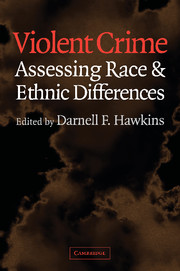Book contents
- Frontmatter
- Contents
- Contributors
- Foreword
- Editor's Introduction
- Violent Crime
- Part I Homicide Studies
- Part II Other Contexts, Settings, and Forms of Violence
- 6 Sanction Effects, Violence, and Native North American Street Youth
- 7 Ethnicity and Interpersonal Violence in a New Zealand Birth Cohort
- 8 Racist Victimization in England and Wales
- 9 Race, Gender, and Woman Battering
- 10 Gender Entrapment and African-American Women: An Analysis of Race, Ethnicity, Gender, and Intimate Violence
- Part III Explaining Racial and Ethnic Differences
- References
- Index
8 - Racist Victimization in England and Wales
Published online by Cambridge University Press: 22 August 2009
- Frontmatter
- Contents
- Contributors
- Foreword
- Editor's Introduction
- Violent Crime
- Part I Homicide Studies
- Part II Other Contexts, Settings, and Forms of Violence
- 6 Sanction Effects, Violence, and Native North American Street Youth
- 7 Ethnicity and Interpersonal Violence in a New Zealand Birth Cohort
- 8 Racist Victimization in England and Wales
- 9 Race, Gender, and Woman Battering
- 10 Gender Entrapment and African-American Women: An Analysis of Race, Ethnicity, Gender, and Intimate Violence
- Part III Explaining Racial and Ethnic Differences
- References
- Index
Summary
Introduction
Students of “race,” class, ethnicity, and violent crime in Europe and North America have been preoccupied by the reportedly higher rates of violence committed by ethnic minorities. Although it has been observed that, on both sides of the Atlantic, most crime is committed – unsurprisingly – by the white majority community, popular concern and scholarly attention have focused on the disproportionate rates of arrest and imprisonment among minority communities. As Russell (1998) suggests, a preoccupation with concepts such as “black criminality” and “black-on-black crime” have tended to obscure or ignore the extent of “white-on-white crime” or “white-on-minority” violence, to the extent that the very terms seem odd. A further consequence of the narrow focus of the “race and crime debate” is that, until recently at least, criminologists and others have tended to ignore racist violence; that is, violence specifically targeted against ethnic minority communities and incidents that are aggravated by racism and racial prejudice.
In recent years, this situation has started to change significantly. In the 1980s, public concern about racist violence increased in North America (Hamm, 1993), continental Europe (Bjorgo and Witte, 1993), and Britain (Bowling, 1999), which led to the development of new directions in research and public policy. During the 1990s, a number of well-publicized incidents heightened this concern about racist violence in numerous places. In the early 1990s in Germany, for example, there was a spate of arson attacks against asylum seekers' hostels and the homes of people from ethnic minorities.
- Type
- Chapter
- Information
- Violent CrimeAssessing Race and Ethnic Differences, pp. 154 - 170Publisher: Cambridge University PressPrint publication year: 2003
- 4
- Cited by

